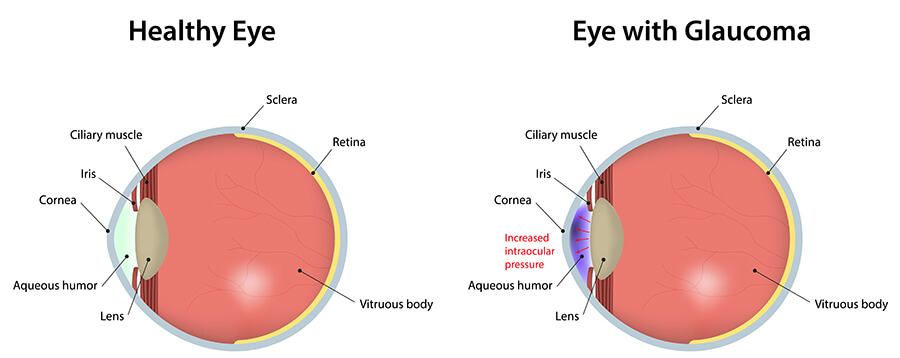GLAUCOMA
Glaucoma is a disease of the optic nerve, which is the part of the eye that carries the images we see from the eye to the brain. The optic nerve is made up of many nerve fibers (like an electric cable containing numerous wires). Glaucoma damages nerve fibers, which can cause blind spots in our vision and vision loss to develop.
Glaucoma has to do with the pressure inside the eye, or intraocular pressure (IOP). When the clear liquid called the aqueous humor–which normally flows in and out of the eye–cannot drain properly, pressure builds up in the eye. The resulting increase in IOP can damage the optic nerve.
The most common form of glaucoma is primary open-angle glaucoma, where the aqueous fluid that normally circulates in the front portion of the eye is blocked from flowing back out of the eye through a tiny drainage system. This causes the pressure inside your eye to increase, which can damage the optic nerve and lead to vision loss. Most people who develop primary open-angle glaucoma notice no symptoms until their vision is impaired.
In angle-closure glaucoma, the iris (the colored part of the eye) may drop over and completely close off the drainage angle, abruptly blocking the flow of aqueous fluid and leading to increased IOP or optic nerve damage. In acute angle-closure glaucoma there is a sudden increase in IOP due to the buildup of aqueous fluid. This condition is considered an emergency because optic nerve damage and vision loss can occur within hours of the problem. Symptoms can include nausea, vomiting, seeing halos around light, and eye pain.

Even people with”normal” IOP can experience vision loss from glaucoma. This condition is called normal tension glaucoma. In this type of glaucoma, the optic nerve is damaged even though the IOP is considered normal. Normal tension glaucoma is not well understood, but we do know that lowering IOP has been shown to slow progression of this form of glaucoma.
Childhood glaucoma is rare, and starts in infancy, childhood or adolescence. Like primary open-angle glaucoma, there are few, if any, symptoms in the early stage. Blindness can result if it is left untreated. Like most types of glaucoma, this type of glaucoma may run in families. Your ophthalmologist may tell you that you are at risk for glaucoma if you have one or more risk factors, including elevated IOP, a family history of glaucoma, a particular ethnic background, advanced age, or certain optic nerve conditions. Regular examinations with your ophthalmologist are important if you are at risk for this condition.

With 18 years of established experience and thousands of procedures performed, Dr. Kaldawy is happy to offer state-of-the-art medical and surgical treatment for glaucoma including the new iStent inject.
The iStent inject is small device that can help reduce pressure inside the eye. The iStent inject can be performed as a stand-alone surgery or at the same time as cataract surgery.
The iStent inject consists of two very small, titanium stents that are surgically implanted into the trabecular meshwork (the tissue that drains fluid away from the eye). The stents create tiny channels that fluid can drain through, which helps to lower eye pressure.
We are happy to offer state-of-the-art medical and surgical eye care and now SLT laser and the iStent inject for treatment of glaucoma. All procedures are performed closer to home than ever before at the Cataract Surgery Center of Milford.
